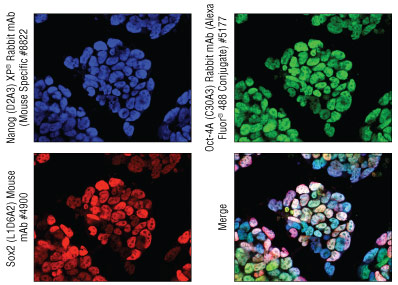Pluripotency is the ability of a cell to differentiate into any cell type. The ability to induce pluripotency in cells from an individual provides a valuable tool for developmental biology studies and disease research studies, and could ultimately be applied to personalized stem cell therapy. Cell Signaling Technology (CST) offers a comprehensive line of stem cell and lineage markers. CST™ antibodies are extensively validated in relevant research applications by our team of in-house experts and validation data is presented online for each product. And our technical support scientists are available for consultation, just in case you need a partner at the bench.
Reprogramming Factors Key: O—Oct4, K—Klf4, S—Sox2, M—c-Myc, E—Esrrb, Nr—Nr5a2, C—C/EBPα, L—Lin28, N—Nanog
| Species | Cell Type | Reprogramming Factors | Reference |
|---|---|---|---|
| Mouse | Fibroblasts | OKSM, OKS, OSE, KSNr | Takahashi & Yamanaka 2006 |
| Mature B & T cells | OKSMC, OKSM | Hanna et al. 2008; Eminli et al. 2009 | |
| Myeloid progenitors | OKSM | Eminli et al. 2009 | |
| Hematopoietic stem cells | OKSM | Eminli et al. 2009 | |
| Adipose-derived stem cells | OKSM | Sugii et al. 2010 | |
| Dermal Papilla | OKM, OK | Tsai et al. 2010 | |
| Satellite cells | OKSM | Tan et al. 2011 | |
| Pancreatic β-cells | OKSM | Stadtfeld et al. 2008 | |
| Hepatic endoderm | OKS | Aoi et al. 2008 | |
| Neural stem cells | OK | Kim et al. 2008; Kim et al. 2009 | |
| Melanocytes | OKM | Utikal et al. 2009 | |
| Human | Fibroblasts | OKSM, OSLN, OKS | Takahashi et al. 2007; Yu et al. 2007; Nakagawa et al. 2008 |
| Mobilized peripheral blood | OKSM | Loh et al. 2009 | |
| Cord blood endothelia | OSLN | Haase et al. 2009 | |
| Cord blood stem cells | OKSM, OS | Eminli et al. 2009; Giorgetti et al. 2009 | |
| Adipose-derived stem cells | OKSM, OKS | Sugii et al. 2010; Aoki et al. 2010 | |
| Hepatocytes | OKSM | Liu et al. 2010 | |
| Keratinocytes | OKSM, OKS | Aasen et al. 2008 | |
| Neural stem cells | O | Kim et al. 2009 | |
| Pancreatic β-cells | OKSM | Bar-Nur et al. 2011 | |
| Amniotic cells | OKSM, OSN | Li et al. 2009; Zhao et al. 2010 |
Table adapted from Stadtfeld and Hochedlinger 2011.
 Adapted from Walsh, Becker and Hochedlinger 2011.
Adapted from Walsh, Becker and Hochedlinger 2011.